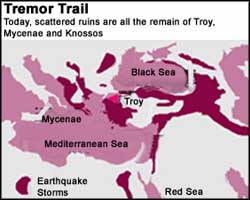The rubble speaks
 around 1200 bce, the Bronze Age civilisations of the Eastern Mediterranean came to a premature end . Within 50 years, several famous centres of scholarship and industry such as Troy, Mycenae and Knossos had been reduced to rubble. Amos Nur, a geophysicist at Stanford University, usa , believes that a string of massive earthquakes could have led to the destruction.
around 1200 bce, the Bronze Age civilisations of the Eastern Mediterranean came to a premature end . Within 50 years, several famous centres of scholarship and industry such as Troy, Mycenae and Knossos had been reduced to rubble. Amos Nur, a geophysicist at Stanford University, usa , believes that a string of massive earthquakes could have led to the destruction.
Historians and archaeologists have been debating the issue for a long time. They have cited civil war, invasion and pestilence as possible causes.
Nur has been studying the role of earthquakes in the Eastern Mediterranean for the last 20 years. Initially, the researcher focused on the wreckage of Megiddo and other ancient cities, and gathered information about the patterns of large quakes. His findings may now help modern geophysicists understand when and why earthquakes occur.
The researcher studied the temporal and spatial patterns of historical earthquakes to identify indicators of future tremors. He chose the Eastern Mediterranean as it has the oldest, most complete record of earthquake activities. Although the history of the region provides evidence of earthquakes, it was the recent advances in understanding of plate tectonics that gave insights into the destruction of ancient cities, the researcher says.
According to the plate tectonics model, the crust or outer layer of the Earth consists of about a dozen large, irregularly shaped plates that slide over, under and past each other. Whenever the plates move relative to each other, sudden dislocations in segments of the crust create fractures or faults. The faults reflect zones of weakness in the crust. This is why earthquakes tend to occur at plate boundaries in these regions.
The city of Megiddo was located at the Nahal Iron Pass. This pass was the only means of traversing the Carmel-Gilboa mountain range on the road from Damascus to Egypt. Excavations suggest that the city was repeatedly devastated by some large force. According to Nur, earthquakes might have certainly played a role in the destruction of Megiddo. Archaeological and historical data support Nur's hypothesis. The researcher talks about crushed skeletons found trapped under the collapsed rubble. The positions of the bodies indicate that these people were struck by a sudden and massive load, he says.
These findings suggest that earthquakes may have played a crucial role in the collapse of nearly 50 cultural centres in the ancient world including Troy, Mycenae and Knossos. According to him, seismic records indicate that large earthquakes are temporally clustered. Short periods of very intense earthquake activity are followed by long intervals of relative quiet.
The geophysicist holds Turkey's North Anatolian Fault responsible for a series of earthquake activity. Between 1939 and 1967, a string of earthquakes split the entire plate boundary along Turkey's North Anatolian Fault, causing a slip of the order of two to four metres.
The cities which were toppled at the end of the Bronze Age were located in regions that have historically experienced high earthquake activity. Nur has calculated the intensities of recent earthquakes and shown that the modern-day regions that experience heavy damage overlap with the ancient cities destroyed at the end of the Bronze Age.
It is not too hard to imagine how earthquakes might have led to the collapse of ancient societies. During these periods, technology to cope would certainly have been limited. So it would have been difficult for societies to rebuild their temples and houses. In the wake of such havoc, skills such as reading and writing could have disappeared if people were concerned with more important activities for survival. Nur says it would have taken many years for these societies to recover from such an event.
After the study, geologists may be led to rethink the role of forces that generate earthquakes. If earthquakes really occur in episodic bursts, they will have to re-evaluate how and when strain is released along plate boundaries. The traditional view is that strain is periodically released at each segment of the plate boundary.
The evidence obtained from Nur's analysis of the Eastern Mediterranean suggests that the strain is released in episodes through a sequence of earthquakes. A tremor in one segment of the plate boundary appears to trigger off a chain reaction of displacements along the rest of the fault. The findings may also have important bearings on the way geophysicists predict the likelihood of future earthquakes. By analysing strong earthquake activities in the past, it may someday become possible to design models that predict active and quiet periods.
